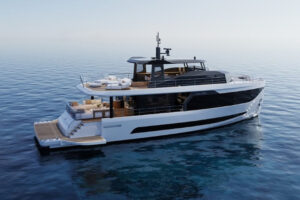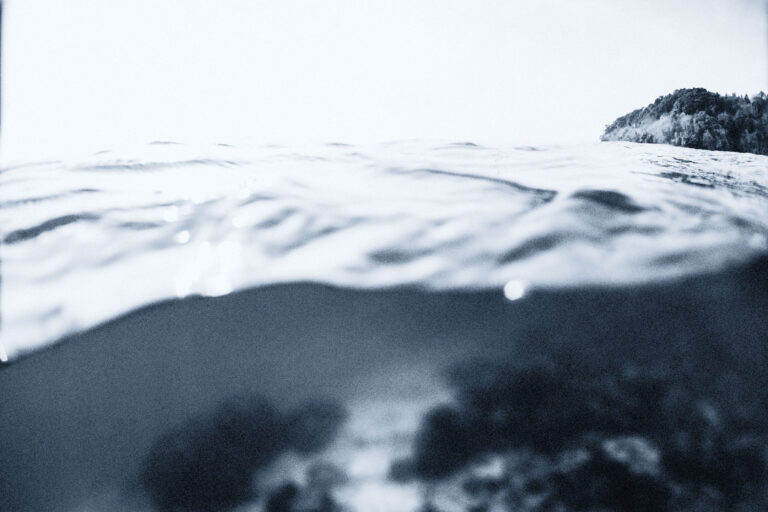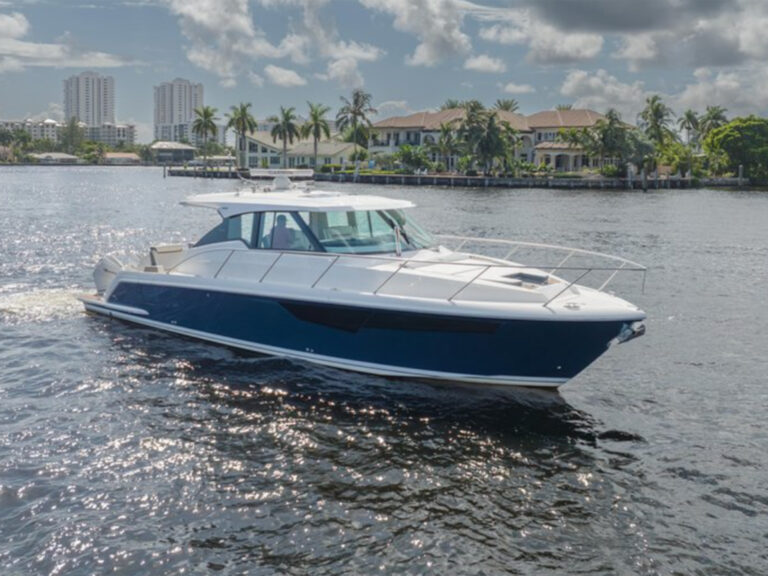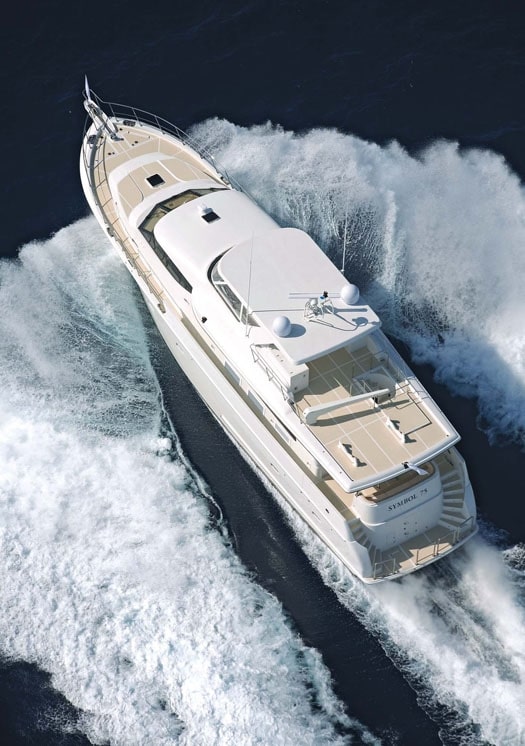
symbol75coverinsidetop.jpg
Every time I look at a new Symbol yacht I can’t help but think of the builder’s first launch. Measuring 42 feet, she was one of the larger boats displayed at the 1983 Miami International Boat Show. Taiwanese boatbuilders were beginning to earn the respect of American yachtsmen and Symbol was one of a wave of builders that were targeting new niches within the active U.S. market. The builder’s latest launch, a 75-foot flushdeck motoryacht, shows just how far Symbol has come.
Symbol has always done things a bit differently. When Taiwan was establishing itself as the cradle of the trawler yacht world, one of Jimmy Cheng’s first boats was a planing-hull design. While other brands shopped yards for production, Cheng established the Symbol brand and built a yard to support it.
More recently, the cost of building boats in Taiwan increased and some builders migrated to China. Cheng has stayed in Taiwan and remains competitive. His 110,500-square-foot facility is near Kaohsiung International Airport. It is here that 150 employees, many of them second generation boatbuilders, craft Symbol’s yachts, which range from 45 to 92 feet.
The 75 is the product of two strong links that Cheng maintains with the U.S. market. Chief among them is yacht designer Jack Sarin, who has been penning Symbol’s designs for the last seven years. Sarin, based in Bainbridge Island, Washington, has been a pioneer in the design of large fiberglass motoryachts. His relationship with Symbol has resulted in a consistent series of eye-pleasing products that have helped reinforce the builder’s mark.
Since 2003, most of Symbol’s larger launches, including the 75, were carefully overseen by Barin Cardenas, president of Ft. Lauderdale-based Lucid Marine. Cardenas entered the boat business with an engineering background, becoming a seasoned project manager. In a sense, he is Symbol’s eyes and ears in South Florida, one of the company’s most important markets. His efforts have proven critical in shaping Symbol’s production to the needs of its customers.
The 75 project is a perfect example of how a new Symbol model comes to life. Her owner is an experienced yachtsman who had migrated through half a dozen boats and was moving up from a 59-footer when he came to Symbol. “This owner liked the interior and exterior styling of our 73-footer but needed a bit more room and a bit more speed,” said Cardenas. The ‘bit more room’ was eleven berths, five staterooms, and four heads. “He has a big family and they all like boating,” explained Cardenas. A cruising speed in the 22-knot range was a must and to complicate matters the boat would have to be designed and equipped so that the owner and his wife could manage it. “It was a challenge and we knew early on that our 73-foot model would not meet his requirements,” said Cardenas. Accepting the challenge, Sarin began crafting a new hull design with a bit more length and a foot more beam. Given the added volume, Cardenas worked with the owner on a new interior layout.
Instead of the 73’s 1,015-horsepower C18 Cats, the 75 is equipped with 1,652-horsepower C32s. When chasing speed, adding horsepower usually adds weight. “We had to increase fuel capacity, beef up the structure, and upgrade the auxiliary systems,” said Cardenas. The net result was an additional 14,300 pounds of displacement but the 75 still made her numbers, logging a top speed of 26.8 knots on her sea trials in South Florida. During my sea trial, I noted 24.4 knots at 2239 rpm, a bit short of Cat’s 2300 rpm recommendation. Likely the result of fouling, she was headed to the yard to have her bottom cleaned and her wheels tweaked. She accelerates evenly without a fuss or clouds of smoke and she turns easily, her active stabilizers keeping her steady. Seas were three feet and the breeze carried an occasional wisp of spray while running all out. She is most comfortable at cruising speed. Sarin apparently does not feel trim tabs are necessary and given her modest running angle and active stabilizers, I would agree. While our test data was skewed due to her bottom fouling, I suspect that when she is tuned up and fully loaded she will easily manage her 22-knot target at about 2100 rpm.
Cardenas’ greatest challenge was sculpting the 75’s arrangement. She is a large boat for an owner-operator yet a small boat for eleven to cruise aboard comfortably. Cardenas “sketched” the proposed arrangement using CAD, a skill he had mastered as a project manager. These electronic drawings were e-mailed to Sarin’s office for review and approval. Once Sarin had signed off on the layout, the drawings were e-mailed to the yard where Symbol’s engineers sorted out the details and prepared the working drawings that were used to build the boat. “This is pretty standard practice for us,” said Cardenas. “While we would love to build the same layout twice, we rarely do!”
Cardenas addressed the challenge of owner operation with clever design and new technology. The main cabin is open, which allows the skipper a clear view from the interior helm station to the afterdeck. The doors to the side decks and a ladder to the bridge are a short distance away. The owner can also run the boat with a wireless remote system that controls the main engines and the bow and stern thrusters. Warping windlasses on the afterdeck are used for finetuning once the dock lines are secured.
Underway, the semi-enclosed bridge is the place to be. Helm and companion pedestal seating face the fully equipped helm console and there is a lounge area aft. While the bridge is enclosed with Isinglass, an acrylic door leads aft to a wet bar, a built-in grill, and a stowage console. Deck space aft is reserved for a 15-foot tender and an exterior stairwell that leads below to the afterdeck.
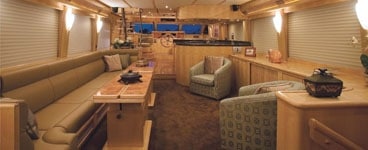
| | |
As is typical for a boat of this size and type, the accommodations are split fore and aft of the engineroom. Usually crew’s quarters would be aft but as there was no requirement for crew, Cardenas used the space for a full-beam master stateroom. Stairs from the main cabin lead below to a foyer where one door leads to the master stateroom and another watertight door in the foyer leads to the engineroom. Cardenas left enough space aft for a transom compartment.Accessible from the integral swim platform, this compartment is used for storing dock lines and fenders. Stairs in the main cabin forward lead below to four guest staterooms and three heads. There are two queen-sized berths and five single berths (including a Pullman) for a total of nine guests. The amazing thing is that the arrangement does not seem at all cramped. Symbol offers a wide variety of interior woods and finishes. The 75’s owner chose highgloss maple.
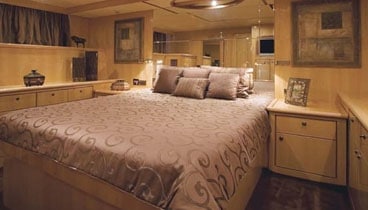
| | |
There is really no stock 75 per se. In fact, Cardenas explained that her new 19-foot, 6-inch beam hull is already serving as the foundation for a new 82-foot skylounge yacht-fisherman that is currently under construction at the yard. Given this flexibility, Symbol develops pricing for each boat that is tied to the specifications and drawings that Cardenas prepares for his customers. “Once we have things nailed down we determine a price, all up, turnkey,” he said. During a typical project, Cardenas will make two trips to the yard and receive weekly updates from his project manager. If you’re feeling creative a new 75 takes about twelve months from contract to delivery and costs about $3.5 million. This is a good value for a semi-custom motoryacht.
Symbol Yachts, +866 7 787 3157; www.symbolyachts.com Lucid Marine, (954) 318-7973; www.lucidmarine.com



